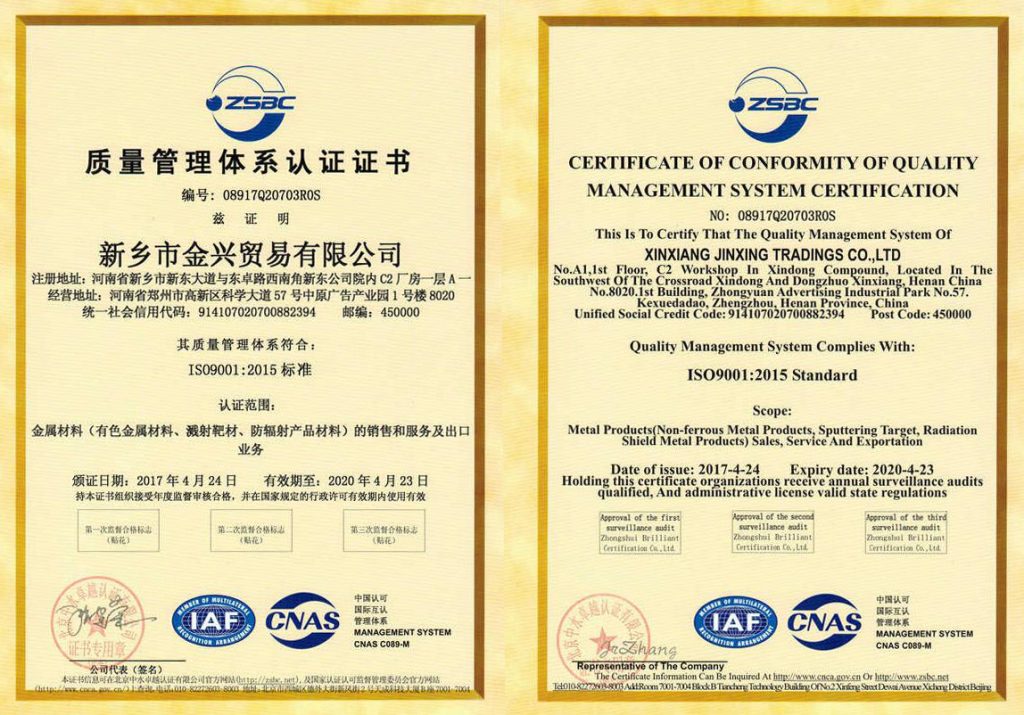High quality hot sale Tungsten alloy, Tungsten copper alloy from JINXING Matmetals
Tungsten copper alloy is consisting of tungsten and copper, copper content of 10% to 50%. made of powder metallurgy alloy. It has good electrical and thermal conductivity, good high temperature strength and a certain plasticity. At high temperatures, such as above 3000 ℃. The copper alloy is liquid evaporates,absorbs heat, reducing the surface temperature. Therefore, these materials are also known as metallic sweat material.
Tungsten copper alloy have a wide purpose, mainly used to manufacture anti-arc ablation of high-voltage electrical switch contacts and the rocket nozzle throat insert, rudder and other high temperature components, and also used for EDM electrode, high temperature moldsand other thermal conductivity and high temperature performance required to usethe occasion. Fine selection of tungsten copper tungsten, copper powder, refine dart soak sintering process, can withstand the high stress of nearly 2,000 high moderate, high melting point, high hardness, anti-burning and good anti-adhesion, electrical erosion product surface finish high, high precision, low loss.

Tungsten copper is widely used as high-pressure, super-hydraulicswitch and circuit breaker contact, protection ring for electric upsetting anvil block of material, conductive Tsui automatic submerged arc welding, plasma cutting nozzles, welding machines, welding head for welding , roll welding wheels,electrode and the point of sealing gas Mao spark electrodes, spot welding, butt welding materials.
We have a large amount of tungsten alloy rod stock for sale.Most of the major applications for tungsten alloy rod are based on its very high density where it is used to control or distribute weight in some way. The product can be machined further.
tungsten can offer tungsten alloy rods and parts as counterweight, radiation shielding, military defense applications, welding rods, extrusion dies. Some sports also, facilitate the use of alloy rods, such as darts, billets, golf club, etc. In addition, we can manufacture and offer they as the replacement of one type of famous materil, with very similar properties.
Tungsten alloy rods also have other usages: electric vacuum parts and it can be used as a means of high temperature structure parts. The product also for some sports fields, such as darts, billets, golf clubs, etc.
Because of their very high melting point and have a density twice that of steel and are more than 50% heavier than lead. Tungsten alloy shapes are widely used in smelting, lighting, medical treatment, decoration, military, spaceflight and aviation, etc. Most popular classification of tungsten alloy shapes is per application. Most of the major applications for tungsten heavy alloys rods are based on its very high density where they are used to control or distribute weight in some way, they often used in radiation shielding, source holder for radioactive materials, X-ray, and medical instruments parts etc. Tungsten heavy alloy brick can be manufactured for the parts of military applications, as extrusion die or some counterweights. Tungsten heavy alloy plate is widely used in fields, such as sports goods, counterweight products, medical equipment, etc. Tungsten in bar form is most often supplied as 99.99% pure tungsten, which can be brittle. Tungsten heavy alloy bars are used for end mill extensions, arbors, tool holders, grinding quills, and boring bars. Tungsten heavy alloy balls are used in the weapons projectiles, armor piercing ammunition, hunting pellets, counterweights and prefabricated fragments
Nuclear medical radiation shielding : tungsten alloy(heavy alloy) is ideal for shielding against X rays and gamma radiation. The very high density of tungsten shielding (more than 60% denser than lead) allows a reduction in the physical size of shielding components, without compromising their rigidity or the effectiveness of the shielding characteristics. tungsten heavy alloy shielding is used in applications such as collimator, nuclear shielding, beamstop, PET syringe shield, vial shield, isotope container, FDG container, multi leaf collimator etc. Positron emission tomography (PET) Positron emission tomography (PET) is one of the nuclear medicine techniques available for diagnosis. Whilst X-rays provide information on the structure of the body, PET shows the chemical function of a particular organism. PET involves the injection of FDG (a glucose-based radionuclide) from a shielded syringe into the patient. As the FDG travels through the patient s body it emits gamma radiation which is detected by a gamma camera, from which the chemical activity within cells and organs can be seen. Any abnormal chemical activity may be a sign that tumours are present. PET scans are frequently used to detect cancerous tumours and diseases of the brain and coronary arteries. Applications for tungsten alloy shielding in PET include: PET syringe shield Tungsten vial shield Tungsten FDG transport container Collimator for gamma camera Technetium generator Multi leaf collimator Radiotherapy destroys cancer by directing beams of radiation directly onto the tumour. The beams of radiation require a very fine focus to avoid harming the surrounding healthy tissue. This focus is achieved by using a multi-leaf collimator , consisting of two rows of very thin tungsten alloy plates, which can be configured to exactly match the dimensions of the tumour.



